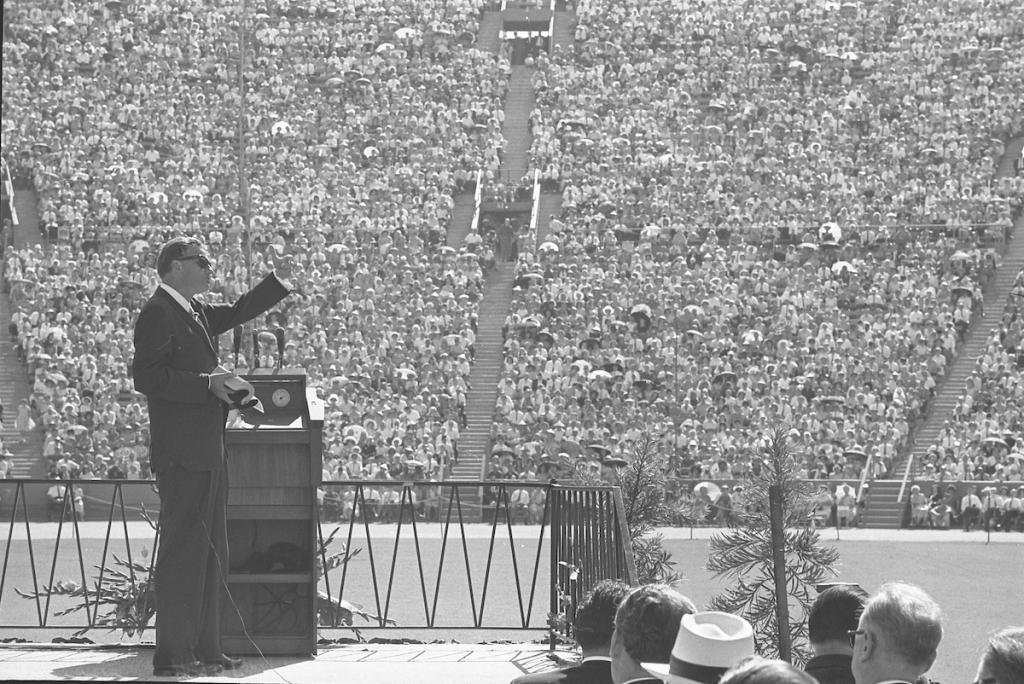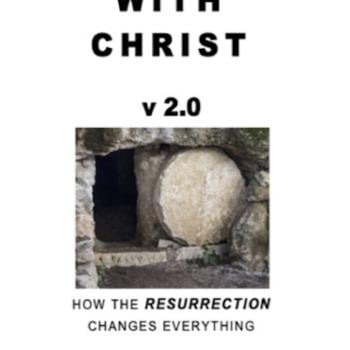
History teaches us that the greatest need of the church today is a revival. Revival is a wide-scale outworking of Jesus’ resurrection power.
Will you not revive us again, that your people may rejoice
in you? Show us your steadfast love, O Lord, and grant us your salvation. PSALM 85:6–7
A series of advertisements on British television move me close to tears every time I see them. They begin with someone crying, hugging a loved one. A voice begins, “When I was diagnosed with cancer . . .” You appreciate immediately the terrible impact of the word “cancer.” After a few seconds the patient says, “Today I was told I have my life back.” Suddenly you realize that the person is crying for joy, not anguish, and through their tears a smile appears. This commercial reminds us of the power of death and of the precious nature of life. The thread by which we hang on to life is so slender.[1]
We all begin to die the moment we are born. Death is at work in us in many ways. When we are sick we sometimes say, “I feel half-dead.” It is also common to speak of emotional death when bad things happen to us. When a relationship breaks down we might say, “I died on the inside.” Is the reason we speak of death in this way because we instinctively realize that it is not God’s original purpose for us?
Jesus was our obedience substitute during his life, our punishment substitute in his death, and our rebirth substitute in his resurrection. When we become united with Jesus, his life of obedience, his painful death, and his resurrection into glorious power are all credited to us. When someone becomes a Christian, a spiritually dead person is united with a life-giving one. His resurrection produces a resurrection in us. We are connected to the same power that raised Christ from the dead.
Our Christian lives can be a daily experience of sharing in the power of Christ’s resurrection. The word resurrection comes from the same root as resurgence or rising again. God is in the business of reviving, restoring, and renewing or, if you like, fixing us. God is an expert in revival, and he wants our lives on this earth to increasingly mirror heaven. On earth we will always live with the tension of the now and the not yet. Even when we are in the midst of difficulties, however, he wants us to learn to live “life . . . to the full” (John 10:10, niv). This will lead to, among other things, a sense of joy and peace, which will cause many to question why we are so different.
The church today does not always live in the good of what Jesus has done and needs widespread revival. History reveals that periods of stability or decline have been punctuated by the sudden, sovereign, and miraculous intervention of God. When this happens, the church seems to be resurrected from a state of near deadness. Throughout history these revivals have demonstrated the power of God.
One motivation behind this book is to encourage a deeper longing for an experience of Christianity that is truly beyond the natural realm. For if there is one thing the resurrection teaches us, it is that God is miraculous. If God can intervene in human history in such a dramatic way, it is a small thing for him to do so in other ways. In revivals the church en masse experiences more fully the change made possible by the resurrection.
WHAT IS REVIVAL?
Today we do not speak much about revival. Many of us are cynical about it. We have heard it all before, and yet there has been no major revival in the English-speaking world during our lifetime. Possibly such cynicism is caused by a misunderstanding of the meaning of revival and our failure to appropriate what I call a personal revival. This experience is available to all Christians individually, even outside of a generalized revival affecting a broad geographical area. This chapter will attempt to define revival and prepare us for subsequent chapters that will outline how we can connect to God’s reviving power.
History teaches us that the greatest need of the church today is a revival. Yet there is great confusion about what revival actually is. Revival is nothing more than a wide-scale outworking of Jesus’ resurrection power. It is the restoration of life to dead or near-dead beings. A revival could almost be described as a resurrection. Having examined church history, Stuart Piggin defines revival:
Revival is a sovereign work of God the heavenly Father, manifesting his glory on the earth. It consists of a powerful intensification by Jesus of the Holy Spirit’s normal activity of testifying to the Savior, accentuating the doctrines of grace, and convicting, converting, regenerating, and sanctifying large numbers of people at the same time. It is therefore a community experience.
It is occasionally preceded by an expectation that God is about to do something exceptional; it is usually preceded by an extraordinary unity and prayerfulness among Christians; and it is always accompanied by the revitalization of the church, the conversion of large numbers of unbelievers, and the reduction of sinful practices in the community.[2]
The key phrase in this definition is “a powerful intensification by Jesus of the Holy Spirit’s normal activity.” Too often people misunderstand revival as something totally different in its very nature from anything we normally experience. We might ask God to send a revival and expect that the experience will be totally new to us. Actually, a revival is something that is only quantitatively different from what we can experience normally rather than something qualitatively unique. It is an escalation of the usual work of the Spirit to connect us directly with the life-giving power of the resurrected Jesus. In other words, the Spirit of revival is always available to us. Thus, when a revival comes, we should recognize it as a greater manifestation of normal Christianity. The writer of Hebrews reminds us, “Jesus Christ is the same yesterday and today and forever” (Hebrews 13:8).
Understanding it in this way protects us from the disappointment and cynicism that can result if we feel we are not in any way connected to revival. We can learn to recognize when the reviving work of God is going on around or within us and can sometimes identify local moves of God as mini revivals. It also helps us to realize that we can cooperate with God’s reviving work or resist it, and those decisions do influence our experience. We need to stop seeing revival as something “out there” and instead expect to experience what Jesus planned for us through his resurrection. If we experience personal revival and it begins to spread, then, history suggests, church growth will result. Martyn Lloyd-Jones writes:
If you look back across the history of the Christian church, you immediately find that the story of the church has not been a straight line, a level record of achievement. The history of the church has been a history of ups and downs. It is there to be seen on the very surface. When you read the history of the past you find that there have been periods in the history of the church when she has been full of life, and vigor, and power. The statistics prove that people crowded to the house of God, whole numbers of people who were anxious and eager to belong to the Christian church.
Then the church was filled with life, and she had great power; the Gospel was preached with authority, large numbers of people were converted regularly, day by day, and week by week. Christian people delighted in prayer. You did not have to whip them up to prayer meetings, you could not keep them away. They did not want to go home, they would stay all night praying. The whole church was alive and full of power, and of vigor, and of might. And men and women were able to tell of rich experiences of the grace of God, visitations of his Spirit, a knowledge of the love of God that thrilled them, and moved them, and made them feel that it was more precious than the whole world. And, as a consequence of all that, the whole life of the country was affected and changed.[3]
REVIVAL IN ACTS
Even in the early church God’s blessing came in waves, with differing geographical extent and depth. We read how the gospel spread through sudden and successive dramatic outpourings of the Spirit’s intensified activity. It is not a story of unmitigated and uninterrupted success. We often forget that the book of Acts is a collection of edited highlights of events that occurred over several years. Because the early church experienced these seasons of revival and other quieter periods, examining their experiences is the best way for us to learn how to identify what revivals look like.
Some people argue that we cannot use narrative sections of Scripture to teach doctrine. But, ironically, this goes directly against a clear doctrinal statement from one of the epistles:
All Scripture is breathed out by God and profitable for teaching, for reproof, for correction, and for training in righteousness. (2 Timothy 3:16)
Acts, like all Scripture, must have a role in forming our doctrine and shaping our practice. The book of Acts is unique in the historical books of the Bible in that the mistakes of its heroes are almost never reported. Even when difficulties arose, such as over the applicability of Jewish law and the argument over John Mark, the focus is on how the problems were resolved. Major issues that arose in churches and are addressed by the epistles are not even mentioned. As Luke was a trusted associate of Paul, this is surprising since he certainly would have known all about what had happened. Acts has all the hallmarks of being a model account of how church mission should ideally proceed. It is a collection of highlights of the good times experienced by the church, without being in any way misleading.
In Acts 2, we find what is in some ways the archetypal revival. Perhaps we have felt some disappointment that it has been more than one hundred years since the last widespread revival in North America or mainland Britain. Yet the coming of Jesus and the subsequent events of Pentecost occurred after more than four hundred years of silence from God! During that time there was no recorded divine activity.
Suddenly the church was born following the life, death, and resurrection of Christ. In the upper room a few believers gathered to pray; then something dramatic happened, and the transformed Peter began to preach boldly. He had been awakened. He was no longer frightened; he had been revived. The result of all this was the addition of three thousand men, plus women and children, to the church in one day.
A pattern that mirrors what happened at Pentecost can be seen in almost every subsequent revival in church history. First the church experienced a period during which there was a new and more intense emphasis on prayer. Following that, something dramatic and God-given occurred—in this case, the descent of the Holy Spirit on the believers. This work of the Spirit was designed to connect believers to the life-giving resurrection power of Christ.
Once the believers had themselves been revived, the gospel was simply but boldly preached. As a result, the life-giving power of the Word of God was unleashed. Once the church herself had been empowered from on high, then large numbers of people were saved. A revival is something that happens to individual Christians first and only subsequently has implications for those on the outside. Once a significant number of God’s people are experiencing more of the change that the resurrection brings, a large number of conversions seems almost inevitable. Such “awakened” Christians are infectious in their joy in God, delight in telling people about the love of God for them, and tremble at thinking about the eternal state of the unbeliever.
Because of the clear link between what we read in Acts and what has been described in revivals in church history, my own preferred definition of revival is: the return of the church to something of the experience of the book of Acts. It is a “return” because often our experience seems very dissimilar to that recorded in the book of Acts. I deliberately say “something of the experience” to allow for the variations seen in revivals and to include what I call mini revivals. This approach to revival is helpful as we each seek to be changed by the resurrection of Jesus irrespective of what is happening around us. It is possible for any Christian today to return to at least something of the experience of the book of Acts.
REVIVALS IN CHURCH HISTORY
Throughout history many times it was thought that the church would die out, but suddenly God intervened. The church has always grown in fits and starts, with special times of blessing on both a local and more widespread scale. The history of the church shows that the fires of revival are often lit when one person connects with God’s reviving power and this power then spreads to others. For example, over his twenty-five years of ministry, Charles Spurgeon experienced a personal revival that affected his own church before, during, and after the more widespread 1859 revival. He learned how to ride the sovereign waves of revival, and when these subsided, his preaching continued to be powerfully anointed. Many were saved, and hundreds of church plants resulted from Spurgeon’s connection to God’s reviving Spirit. John Piper has published helpful, brief accounts online of the life of Spurgeon and several other individuals who experienced revival.[4]
Another example was John Knox, who lived during the time of the Reformation and said, “God did so multiply our number that it appeared as if men had rained from the clouds.” It was said that almost the whole of Scotland turned to Christ in just a few years.[5] Richard Baxter similarly saw almost every family in Kidderminster turn from godlessness to the Christian faith during his ministry. The Wesley brothers, George Whitefield, and Jonathan Edwards were all part of an amazing work of God that stretched from the American colonies to England. Dramatic changes in society are often seen during revivals. During the Welsh revival of 1904, it was said that pit ponies, used in coal mines, would no longer work because their masters had stopped swearing at them.
Possibly the clearest account of God’s supernatural power in revival is a description of the Lewis revival of 1949. Once while visiting the Scottish island of Lewis, it was a real delight to speak with a woman who had lived through this revival. The unmistakable sparkle in her eyes when speaking about those events struck me profoundly. Here is how a revival historian describes what happened:
Duncan Campbell, an evangelist, came to the Island of Lewis in the Hebrides Islands. On the first night of his arrival, he preached in a church building. When he left the building at 11 p.m. he found 600 gathered outside; 100 from the nearby dance hall; the other 500 who had been awakened, got out of bed, and felt compelled to walk to this place. Campbell preached the gospel to them till 4 a.m., at which time he was requested to come to the police station where 400 people were gathered, baffled as to why they were there. On his way to the station he came across other people along the road who were crying out to God for mercy! Revival continued for 3 years with 75% of the converts coming to Jesus outside of church buildings.[6]
There have been many similar occurrences in other countries around the world. Studying such accounts produces a hunger in us to see the same thing today. Martyn Lloyd-Jones said:
[Normal life outside of a revival] can produce a number of converts, thank God for that, and that goes on regularly in evangelical churches every Sunday. But the need today is much too great for that. The need today is for an authentication of God, of the supernatural, of the spiritual, of the eternal, and this can only be answered by God graciously hearing our cry and shedding forth again his Spirit upon us and filling us as he kept filling the early church.
What is needed is some mighty demonstration of the power of God, some enactment of the Almighty, that will compel people to pay attention, and to look, and to listen. And the history of all the revivals of the past indicates so clearly that that is invariably the effect of revival, without any exception at all. That is why I am calling attention to revival. That is why I am urging you to pray for this. When God acts, he can do more in a minute than man with his organizing can do in 50 years.[7]
REVIVAL TODAY
When we hear stories like these, we need not fall into the temptation of feeling nostalgic or becoming discouraged. Today, from a global perspective, we are seeing the largest revival the world has ever seen. The growth of the church in Africa, South America, and across Asia has been phenomenal. God has done great works in the past, and he is continuing to do great works now. If we understand that revival is directly related to our own personal experience, albeit with a greater intensity, such accounts will thrill us and make us long to experience more revival ourselves. As we read about what God has done in the past, we can recognize some similarities with our current Christian experience.
Revival is often characterized by protracted seasons of prayer. I personally experienced such a mini revival as a teenager. When I arrived at a new school at the age of thirteen, several of the students had been meeting for prayer early every morning before class. These children had decided quite spontaneously to begin to pray. And pray they did! There was an awareness of the presence of God in the room in such a weighty manner that I remember only a handful of other times in my life when God has felt as close as he did then. There was a seriousness, as well as a joy, about it. Students would come to the prayer meetings not quite knowing why, and some would become Christians there and then. There were tears sometimes. There was a sense of God “undoing you” in the room—he revealed himself in his fearful holiness, and boy, did you want to get yourself sorted out. Although there weren’t hundreds of conversions, even now I look back on those days and pray, “Do it again, Lord!”
A study of the history of revival will show us what we might expect if, in our day, God sends a sovereign and widespread revival. As in the case of Jesus’ first miracle, God seems to save the best wine until last. Many of those who have gone before us, and whom we respect, have predicted great times ahead. Of these, perhaps one of the most famous predictions was given by Latimer before he and his friend were martyred: “Be of good cheer, Ridley, and play the man. We shall this day, by God’s grace light up such a candle in England, as I trust will never be put out.”[8] Latimer has not been proven wrong yet, although people are now beginning to predict the wholesale demise of the church in my nation. We must pray for God to intervene and meanwhile play our part in re-evangelizing the nation. We cannot afford to wait until preaching the word is “in season” again (see 2 Timothy 4:2).
There is biblical warrant to optimistically expect a global end-time revival before Jesus returns. This view is perhaps best described and defended in Iain Murray’s book The Puritan Hope. The argument comes from Romans 9–11 that following a period of a hardening of the Jews, large numbers of both Gentiles and Jews will be converted.
Other passages also promise great success to the church, leading to large numbers of people becoming Christians. Isaiah 9:7 proclaims, “Of the increase of his government and of peace there will be no end.” Habakkuk 2:14 states, “For the earth will be filled with the knowledge of the glory of the Lord as the waters cover the sea.” Jesus himself promised that “this gospel of the kingdom will be proclaimed throughout the whole world as a testimony to all nations, and then the end will come” (Matthew 24:14). Perhaps the most widely quoted of such passages is found in Revelation 7:9–10:
After this I looked, and behold, a great multitude that no one could number, from every nation, from all tribes and peoples and languages, standing before the throne and before the Lamb.
REVIVAL AND ME
The single greatest need of the church today is to connect to the resurrection power of God seen in the book of Acts and mirrored throughout church history in revivals. To state the obvious, the church is made up of individuals. A revival is quite simply a group of those individuals all making a vibrant connection to Christ’s resurrection power. This is possible for any individual Christian even outside of revivals.
Both the biblical accounts in Acts and the study of revivals in church history teach us that two things are emphasized whenever a group of people experience a revival—prayer and the Word of God. It seems reasonable, then, to assume that a focus on such things will also lead to individual renewal. Learning to pray effectively and allowing God’s life-changing Word to shape our lives is the only way to diligently seek God. Only by prayer and Bible study can we connect with the life-changing power of God that Jesus obtained for us through his resurrection.
REFERENCES ARE FOUND AT THE BOTTOM OF THIS PAGE
Raised With Christ would never have been possible without heavy use of Logos Bible Software. If you do not yet have this wonderful Bible Study tool or you are due an upgrade, readers of this blog get a 10% discount.
READ MORE
Chapter One:
Chapter Two:
Chapter Three:
Resurrection: Fact or Fiction? Did Jesus Rise from the Dead?
Chapter Four:
Chapter Five:
Chapter Six:
Chapter Seven:
Chapter Eight:
Chapter Nine:
Chapter Ten:
REFERENCES
[1]An example of this series of ads appears online at http://www.tellyads.com/show_movie.php?filename=TA2056&advertiser=Cancer%20Research.
[2]Stuart Piggin, “The Lord’s Firestorms: God the Holy Trinity and the Experience of Religious Revival in Australia”; http://www.anchist.mq.edu.au/CTE/Documents/BCV%20LECTURE%20ON%20REVIVAL.doc.
[3]Martyn Lloyd-Jones, Revival (Wheaton, IL: Crossway, 1987), 26.
[4] John Piper, Biographical Messages; http://www.desiringgod.org/ResourceLibrary/Biographies/.
[5]Iain Murray, “The Puritans and Revival Christianity,” Banner of Truth Magazine, September 1969, No. 72; http://www.puritansermons.com/banner/murray2.htm.
[6]Nate Krupp, The Church Triumphant (Shippensburg, PA: Destiny Image Publishers, 1988), 26–27.
[7]Lloyd-Jones, Revival, 121–122.
[8] John Foxe, Foxe’s Book of Martyrs (Charleston, SC: Forgotten Books, 2007), 299. First published in 1563.














